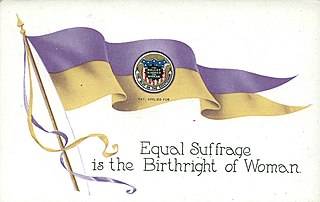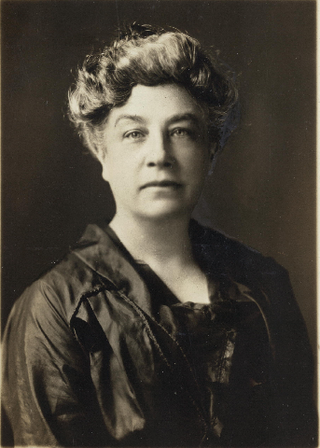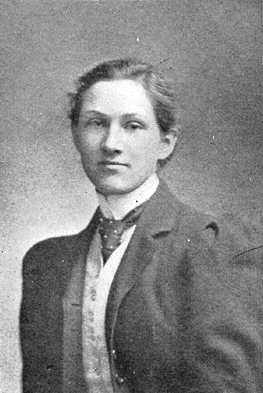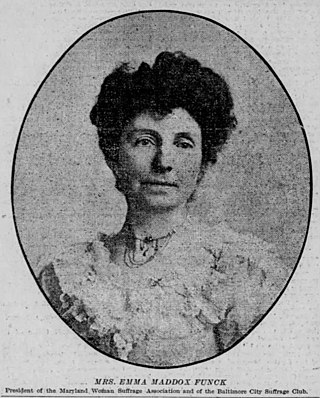
The Nineteenth Amendment to the United States Constitution prohibits the United States and its states from denying the right to vote to citizens of the United States on the basis of sex, in effect recognizing the right of women to vote. The amendment was the culmination of a decades-long movement for women's suffrage in the United States, at both the state and national levels, and was part of the worldwide movement towards women's suffrage and part of the wider women's rights movement. The first women's suffrage amendment was introduced in Congress in 1878. However, a suffrage amendment did not pass the House of Representatives until May 21, 1919, which was quickly followed by the Senate, on June 4, 1919. It was then submitted to the states for ratification, achieving the requisite 36 ratifications to secure adoption, and thereby go into effect, on August 18, 1920. The Nineteenth Amendment's adoption was certified on August 26, 1920.

The National American Woman Suffrage Association (NAWSA) was an organization formed on February 18, 1890, to advocate in favor of women's suffrage in the United States. It was created by the merger of two existing organizations, the National Woman Suffrage Association (NWSA) and the American Woman Suffrage Association (AWSA). Its membership, which was about seven thousand at the time it was formed, eventually increased to two million, making it the largest voluntary organization in the nation. It played a pivotal role in the passing of the Nineteenth Amendment to the United States Constitution, which in 1920 guaranteed women's right to vote.

Carrie Chapman Catt was an American women's suffrage leader who campaigned for the Nineteenth Amendment to the United States Constitution, which gave U.S. women the right to vote in 1920. Catt served as president of the National American Woman Suffrage Association from 1900 to 1904 and 1915 to 1920. She founded the League of Women Voters in 1920 and the International Woman Suffrage Alliance in 1904, which was later named International Alliance of Women. She "led an army of voteless women in 1919 to pressure Congress to pass the constitutional amendment giving them the right to vote and convinced state legislatures to ratify it in 1920". She "was one of the best-known women in the United States in the first half of the twentieth century and was on all lists of famous American women."

The National Woman's Party (NWP) was an American women's political organization formed in 1916 to fight for women's suffrage. After achieving this goal with the 1920 adoption of the Nineteenth Amendment to the United States Constitution, the NWP advocated for other issues including the Equal Rights Amendment. The most prominent leader of the National Woman's Party was Alice Paul, and its most notable event was the 1917–1919 Silent Sentinels vigil outside the gates of the White House.

Lucy Burns was an American suffragist and women's rights advocate. She was a passionate activist in the United States and the United Kingdom, who joined the militant suffragettes. Burns was a close friend of Alice Paul, and together they ultimately formed the National Woman's Party.

Women's suffrage, or the right to vote, was established in the United States over the course of more than half a century, first in various states and localities, sometimes on a limited basis, and then nationally in 1920 with the ratification of the 19th Amendment to the United States Constitution.

The Congressional Union for Woman Suffrage was an American organization formed in 1913 led by Alice Paul and Lucy Burns to campaign for a constitutional amendment guaranteeing women's suffrage. It was inspired by the United Kingdom's suffragette movement, which Paul and Burns had taken part in. Their continuous campaigning drew attention from congressmen, and in 1914 they were successful in forcing the amendment onto the floor for the first time in decades.

Woman's Journal was an American women's rights periodical published from 1870 to 1931. It was founded in 1870 in Boston, Massachusetts, by Lucy Stone and her husband Henry Browne Blackwell as a weekly newspaper. In 1917 it was purchased by Carrie Chapman Catt's Leslie Woman Suffrage Commission and merged with The Woman Voter and National Suffrage News to become known as The Woman Citizen. It served as the official organ of the National American Woman Suffrage Association until 1920, when the organization was reformed as the League of Women Voters, and the Nineteenth Amendment to the United States Constitution was passed granting women the right to vote. Publication of Woman Citizen slowed from weekly, to bi-weekly, to monthly. In 1927, it was renamed The Woman's Journal. It ceased publication in June 1931.

Katharine Martha Houghton Hepburn was an American feminist social reformer and a leader of the suffrage movement in the United States. Hepburn served as president of the Connecticut Woman Suffrage Association before joining the National Woman's Party. In 1923 Hepburn formed the Connecticut Branch of the American Birth Control League with two of her friends, Mrs. George Day and Mrs. M. Toscan Bennett. She was the mother and namesake of actress Katharine Hepburn and the grandmother and namesake of actress Katharine Houghton.

The Suffragist was a weekly newspaper published by the Congressional Union for Woman Suffrage in 1913 to advance the cause of women's suffrage. The publication was first envisioned as a small pamphlet by the Congressional Union (CU), a new affiliate of the National American Woman Suffrage Association (NAWSA), which in 1917 became the NWP. It evolved into an eight-page weekly tabloid newspaper when the first issue appeared on 15 November 1913.

Women's suffrage was established in the United States on a full or partial basis by various towns, counties, states and territories during the latter decades of the 19th century and early part of the 20th century. As women received the right to vote in some places, they began running for public office and gaining positions as school board members, county clerks, state legislators, judges, and, in the case of Jeannette Rankin, as a member of Congress.

Kate M. Gordon was an American suffragist, civic leader, and one of the leading advocates of women's voting rights in the Southern United States. Gordon was the organizer of the Southern States Woman Suffrage Conference and directed the 1918 campaign for woman suffrage in the state of Louisiana, the first such statewide effort in the American South.

Edith Houghton Hooker was an American suffragist and social worker. She was a leader of the suffrage movement in Maryland in the early twentieth century and was posthumously inducted into the Maryland Women's Hall of Fame. She was a maternal aunt of actress Katharine Hepburn.

Caroline Katzenstein was an American suffragist, activist, advocate for equal rights, insurance agent, and author. She was active in the local Philadelphia suffragist movement through the Pennsylvania branch of the National American Woman Suffrage Association and the Equal Franchise Society of Philadelphia. She played a role in the formation of the Congressional Union for Women Suffrage, which later became the National Women's Party. Katzenstein was also active in the movement for equal rights, serving on the Women's Joint Legislative Committee with Alice Paul, and championing the cause for the Equal Rights Amendment. She was the author of Lifting the Curtain: the State and National Woman Suffrage Campaigns in Pennsylvania as I Saw Them (1955).

The Southern States Woman Suffrage Conference was a group dedicated to winning voting rights for white women. The group consisted mainly of highly educated, middle and upper class white women of prominent families. They were originally part of the larger National American Woman Suffrage Association (NAWSA), but broke off in 1906. Prominent leaders in the group included Laura Clay and Kate Gordon, who supported and focused on local and state reforms rather than a national amendment. The group applied tactics like the Lost Cause, the belief that the Confederate cause was moral and just, and the Southern strategy, which appealed to white voters by promoting racism.

Emma Maddox Funck was an American suffragist and served as president of the Maryland Woman Suffrage Association (MWSA).
The Maryland Woman Suffrage Association (MWSA) was a woman's suffrage organization in Maryland, USA, founded in 1889.

Mary Elizabeth Pidgeon was an American woman suffrage activist and labor economist.
















